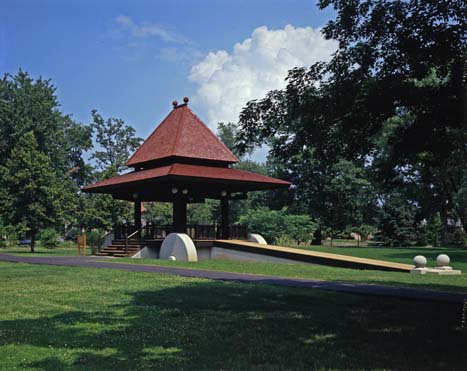Clark Bandstand
Date
1985-presentLocation
Tappan SquareArchitects/Collaborators
Julian Smith & Associates, Architects, Niagara-On-the-Lake, Ontario, Canada (architect)History
The project to build a modern bandstand was begun by President Starr and was carried initially by his enthusiasm for placing a bandstand on Tappan Square for the first time since 1907. Arthur H. "Kenny" Clark, president of Clark Brothers, Inc., offered to pay for the contruction by giving real estate to the College with a value at least equal to the cost of the bandstand project. An advisory committee was established in 1983, grant proposals to the National Endowment for the Arts were drawn up, and the decision to solicit designs in a competitive format was made based “on the desire to create a situation that would provide for an exciting and innovative structure,” according to Mary Durling, project director for the NEA Bandstand grant.In 1985, 30,000 posters were sent out to architects and schools of architecture announcing The Great Bandstand Design Competition. Nearly 400 registration fees were sent in, and ultimately 149 designs were received. The winning entry of architect Julian S. Smith, a 1969 Oberlin graduate, was chosen unanimously by the nine distinguished jurors. One of those jurors, Professor of History Geoffrey Blodgett, spoke of the two most important criteria for his selection process: “that the design did not violate the Oberlin tradition of relative simplicity and modesty,” and “that the structure would have simultaneous appeal to both the town and college constituencies.”
Julian Smith’s winning design offers a great deal more to the community than simply its aesthetic modesty and unconventional imagery. Perhaps the most significant description of the bandstand comes from the architect himself who declares that the design is “unrestricted by European imagery.” The bandstand is certainly in keeping with Oberlin’s social pursuits. “These pursuits, particularly today, are not confined to those based on classical European precedent,” writes Smith. This comment taken from the architect’s statement in which he describes the attraction of “exploring how a long-overlooked medium might be used to open new channels for community expression and integration.”
Source
Brochin, Nathaniel. "The Oberlin Bandstand: An Appropriate Addition." The Oberlin Review (Oberlin, OH), 22 May 1987: 14.
Geolocation
Image Description
Color 4 x 5 in. transparency, © Jennie Jones, photographer, Oberlin, 1988
(Oberlin College Archives, RG 32/9)

